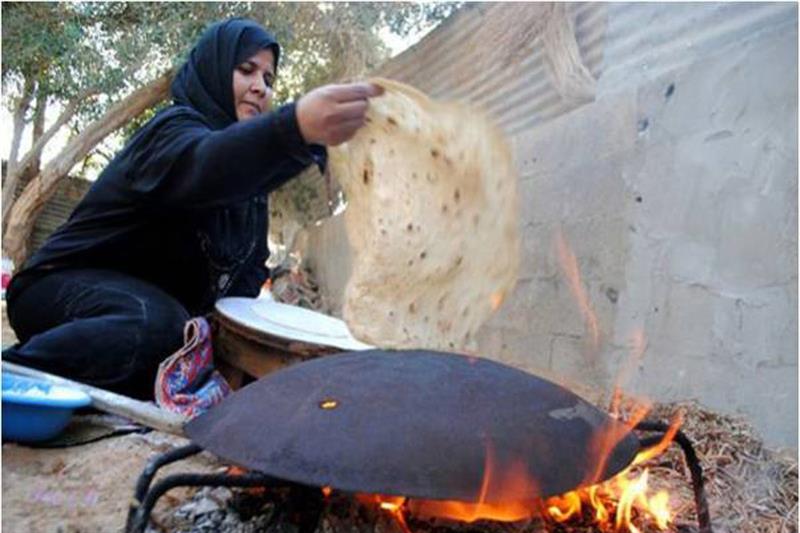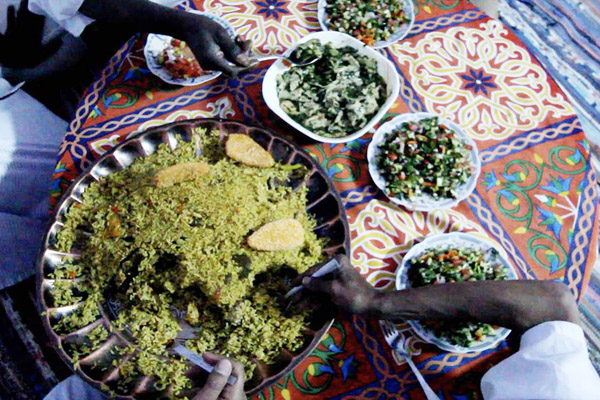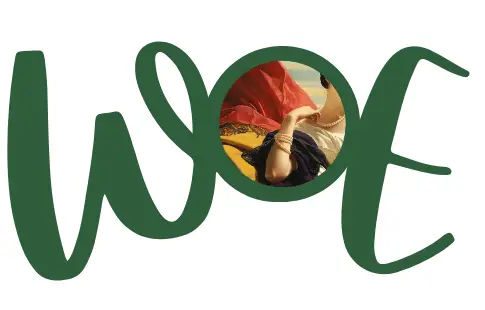March 24, 2023
Dina Al Mahdy

A Bedouin making traditional bread in Sinai
It is the first day of Ramadan, and the spirit of the holy month dominates every corner of Egypt. Lanterns, decorations, the fast-breaking cannon, Ramadan tables, special oriental desserts, and religious singing before the sunset prayers are all common aspects signaling the start of the holy month. Yet, each area of the country celebrates Ramadan in its own unique way, among them Upper Egypt and the Nile Valley to the Mediterranean and Red Sea shores.
Worldwide, Muslims enter the holy month of Ramadan with the same great joy, yet their traditions may differ according to their regional heritage. In Egypt, celebrating Ramadan has its own special manifestations that are quite different from anywhere else in the world.
“Ramadan in Egypt is different from the month in any other Arab and Islamic country” is a common statement made by visitors to Egypt, as it is almost impossible to visit Egypt during Ramadan without observing the Egyptian celebrations and participating in traditions that have become synonymous with the month of fasting.

NUBIA: Ramadan has a special significance for Egypt’s Nubian population in Upper Egypt. As the world changes all around them, the Nubians hold on to traditions that dictate a strong sense of community and local atmosphere.
While many Nubians were relocated to make room for the construction of the Aswan High Dam in the 1960s, a few remained in ancestral villages such as Tinqar, Heissa, and West Suhail where Nubians can connect with their long and complex heritage dating back to around 2500 BCE.
Mohamed Abdallah, a chef from Tingar, says that “the village’s young people continue to uphold our ancient traditions every Ramadan. They start by reading a chapter of the Quran each day before the prayer, and then they go to the Nile where they help to prepare the food for Iftar.”
When the holy month begins, Nubians decorate the streets with Quranic verses and religious motifs on the walls of their houses. Nubian women prepare to celebrate by decorating their feet with henna.
Nubian communities have established a tradition of breaking their fast with group Iftarsattended by every one of their members. “Throughout the month, the locals take turns hosting a banquet prepared by the women for everyone in the village, which can last well into the night as dozens of people break their fast together,” Abdallah said.
“The costs of the group meals are evenly divided amongst the locals, and their doors are always open for neighbours and strangers alike.”
“Once a week, we gather with our close neighbours in front of one of our houses to have Iftar, so that we can feel the Ramadan spirit and keep our traditions alive,” said Heissa native Ahmed Markeb.
Everything that happens in these villages is a group activity in Ramadan, from preparing the food and drink to serving it and setting up the sitting area. The women are in charge of preparing the food, which consists of dishes that are not found elsewhere in Egypt.
After they feast on local delicacies, the locals spend hours chatting with their friends, neighbours, and acquaintances about the news of the village. Nubian women make a special bread called kabid, which is a local staple eaten for Sohour. Jakud is another special local dish eaten during Ramadan and is made from spinach, coriander and dill cooked with chicken or beef stock and seasoned with garlic.
Nile fish recipes are the centrepiece of the table and are eaten with madeed, which is made of flour, milk and bean sprouts. Another kind of Nubian bread is sanasel, which is kneaded and then fermented for several hours.
Refreshments include the Sudanese drink helw-mor (bittersweet), which is flavoured with spices and honey, and abareya made with bread pieces and lemon juice. No Iftar table is complete without the signature juice of abreeg, which is more popular among Egypt’s Nubian communities than any other.
“Abreeg is the favourite drink of all Nubians, and it is the most famous of our traditions. It is made from water filtered through kneaded dough mixed with various kinds of fruit juices such as lemon or hibiscus. It has existed since the days of our ancestors,” said Tinqar local Nasser Anwari.
UPPER EGYPT: “In Upper Egypt, thousands of people march in processions through the streets led by Sufi horsemen carrying tambourines and roaming around the towns and villages,” said Salama Zahran, head of Islamic Monuments in the Upper Egyptian town of Al-Bahnassa at the Ministry of Tourism and Antiquities.
“The women ululate and throw sweets at passers-by from their balconies and windows, wishing them a happy Ramadan filled with peace and prosperity.”
One of the traditional foods in Upper Egypt during Ramadan is sun bread (eish shamsi), a traditional sourdough bread made from wheat flour. Images of making this bread can be seen on the walls of ancient Egyptian temples, and it is traditionally baked at home in domed clay ovens with openings at the top. The name is derived from the way it is made, as the dough is fermented in the sun.
Although this tradition is fading today as bakery bread has become increasingly common, eish shamsi still replaces eish baladi as the local staple with the advent of Ramadan, and women still retain the custom of baking it by letting the dough rise in the sun. Housewives make dozens of loaves and store them in refrigerators so that they are available on their tables throughout the month.
Sun bread is still sold in grocery stores and supermarkets and on the sidewalks of the main streets of Upper Egyptian towns and villages during Ramadan.

LUXOR: Ramadan traditions in Luxor differ from those in other governorates due to the keenness of its people to preserve their traditions.
Before the holy month begins, hundreds of people from the Al-Mataana village in Esna near Luxor march in a procession called “the Sarcophagus of the Awliya” (the Islamic saints). A small cart carries a green wooden casket symbolising the region’s Awliya. Chanters rejoice in praise of the holy month, and women distribute sweets to children.
As part of the celebrations in Naga Sheikh Sultan in Al-Tod south of Luxor, people celebrate the beginning of Ramadan with chants and eulogies in mosques, in which senior chanters sing, and men distribute free Iftar meals to attendees.
Luxor date-traders and fanous (lantern) makers traditionally gather to celebrate the start of the holy month by chanting religious songs and distributing sweets around the city.
Luxor native Hajar Hakim recalls that when she was a child, “children used to decorate the streets with paper models of mosques and colourful lanterns. Ramadan nights were spent in the streets, and my friends and I used to knock on the doors of different houses and show people the mosques we had made.”
She added that among the traditional foods is bettaw, an Upper Egyptian cornbread eaten with dates.
“Sufi Iftars and the Mahmal Parade are the most prominent manifestations of Ramadan in Luxor,” said Hajar. After the sighting of the Ramadan crescent moon, people in Luxor march in a parade called the “Talaat Al-Mahmal” in celebration of the holy month.
Young people and children prepare for the month by collecting money to rent a car carrying musicians along with Nubian singers. They roam the streets carrying colourful flags and chanting folklore songs. The procession is considered the biggest competition between the regions, and by the end of Ramadan the best region in terms of the celebrations is announced.
During the Mahmal Parade, women distribute sweets, sherbet, juices and refreshments. Men wave sticks in the air in rhythm to the music, with the participation of hundreds riding horses and camels.
The Ramadan parade in Esna south of Luxor is held at a different time from those in other towns in the region. People in Esna celebrate in the afternoon, while the locals in other cities march in the evening after the sighting of the crescent.
In the past, Mahmal Parades took place with horses and camels, and later they evolved into a caravan pulled by horses and carrying children chanting religious songs with drums and tambourines.
During the holy month, local Sufis celebrate Ramadan in their own way with group Iftars, circles of remembrance, and religious sermons during the celebration of the major night of the month in each Sufi group. On this night, a long Iftar table is set up welcoming all Sufi sheikhs and followers. One of the most famous groups is named after Sheikh Ahmed Mortada and lays out a huge Iftar table annually on the 9th of Ramadan for thousands of Sufi followers.
Similarly, the Sheikh Gilani and Radwaniyah groups lay out Iftar tables annually on the 22nd and 27th of Ramadan, respectively, offering free Iftars for over 10,000 fasters.
In the surrounding villages, people collect money to set up Iftar tables in the streets for the needy and visitors from neighbouring regions.
QENA: Another tradition takes place in the heart of Upper Egypt in Qena, where a 100-year-old drum beats at the same time twice a day during Ramadan to alert Muslims to stop eating.
This 50 cm piece of copper covered with camel leather is the legacy that local man Abdou Al-Naquib inherited from his grandparents.
“Before sunset and sunrise in the villages of Qena, the drum beats for an hour to remind people to hold or break their fast,” explained Al-Naquib, who grew up and lives in a small village in the area.
The tradition of the copper drum began as a replacement for the famous Ramadan cannon that do not exist in remote areas. Such drums are played in villages by men who have inherited the profession from their ancestors. In the past, the drummers roamed the streets to alert those who were fasting.
HALAYEB AND SHALATEEN: In the southwest of Egypt in the Halayeb and Shalateen Triangle on the Red Sea, the Al-Bishariya, Ababda, and Rashaida tribes have maintained their Ramadan customs and traditions.
The tribesmen’s customs include eating food from the same plate as a symbol of solidarity and out of their belief that “gathering increases the appetite.” Each tribal sheikh takes turns in inviting families and friends over to a banquet during Ramadan. Passers-by and strangers can join the Iftar without an invitation. Another tradition is that young men prepare breakfast by the sea coast.
A popular traditional dish is the salat meal consisting of roasted lamb on heated basalt stones. The drink of the month of Ramadan is gabana coffee, popular among tribesmen living in the Gebel Elba Mountains.
After Iftar and prayers, the tribesmen gather around the fire throughout the night preparing gabana coffee. Over a pile of lit wood that the local Bedouin call rakia, pots full of tea and coffee come to the boil while plumes of shisha smoke rise from among the newly fed Bedouin. The coffee is made by roasting coffee beans over a wood fire. Then it is set aside for a few minutes, and herbs are added to it including cloves, ginger, cardamom, and saffron.
Each serving is enjoyed with a date or two.
SIWA: In the Siwa Oasis in the west of Egypt near the Libyan border, local people have special Ramadan traditions that have been handed down from generation to generation.
Hundreds of years ago, a man would climb the highest mountain in the oasis to search of the crescent moon and announce the beginning of the month by beating a distinct rhythm on a drum. Nowadays, families announce the start of Ramadan by shooting bullets in the air.
At the beginning of Ramadan every year, Siwan young men pass by all the houses of the oasis to collect food or money to be distributed to others as a symbol of solidarity with the poor and needy. The women prepare for Ramadan by cleaning the yards around their houses and hanging bowls of dates outside their homes to welcome guests.
Hamad Khaled Shuaib, a researcher for the Atlas of Egyptian Folklore, said that the people of Siwa consider Ramadan to be a time of spiritual healing. Thus, they refrain from musical or dancing rituals and focus on prayer and reciting the Quran.
The locals in Siwa break their fast with dates and sour milk, and then they perform the sunset prayers in local mosques. One of their traditional drinks is lutbi, which is extracted from the trunk of palm trees.

MARSA MATROUH: Bedouin customs and traditions in Ramadan in Marsa Matrouh have changed dramatically in recent years. However, unlike city-dwellers, the desert Bedouin still maintain many ancient customs and traditions.
The Bedouin take turns hosting a banquet for everyone in the village, where the men of each family and all the families in the region gather to have Iftar in the house of the head of a family who slaughters a sheep for the occasion. Many young men organise trips to the desert or the seashore called zarda in the Bedouin dialect. They then prepare food for Iftar.
The traditional meal for Ramadan in Marsa Matrouh includes Moroccan soup, couscous, red and yellow rice, and roasted barqi lamb. Bedouin women exchange different varieties of food with friends and neighbours in the region, promoting the spirit of solidarity and love.
Similar to the Siwan crescent-sighting ritual, a group of Bedouin climb the highest mountain in Marsa Matrouh to search for the crescent at the beginning of Ramadan, then announcing the start of the month by setting up a fire to notify the neighbouring regions.
SINAI: Amidst the sand dunes and valleys of Egypt’s Sinai Peninsula, the Bedouin tribes preserve ancient traditions that have been passed down from generation to generation.
Sinai shares similar Ramadan customs with many other desert areas. Known for their generosity and hospitality, the people of Sinai are always delighted to welcome guests to their Ramadan tables.
As the call to prayer crackles from radios, the tribesmen prepare to take their first bite of food for Iftar from mountains of rice and goat meat placed on giant platters on handmade carpets in a display that unites the old with the new.
Sohail Imam, a resident of Arish in Sinai, said that “throughout the holy month, food is served and left for hours after Iftar in case a hungry stranger passes by.”
Sheikh Fareej Suleiman, an Al-Huwaitat tribesman, spoke about preparations for the mass gatherings beginning 10 days before the start of the holy month. “The Bedouin set up special areas stocked with food and drink from family homes in the nearby valleys, where people can eat Iftar if they happen to be passing,” he said.
As for local delicacies, the Sinai Bedouin celebrate Ramadan with goat ghee, shisha, and Arabian coffee, the constant companion of the Bedouin in Sinai. One Ramadan staple is gareesha, a dish made from crushed wheat, goat ghee, cumin, herbs, and lentils.
Original Article published in Al Ahram Newspaper o March 21, 2023
